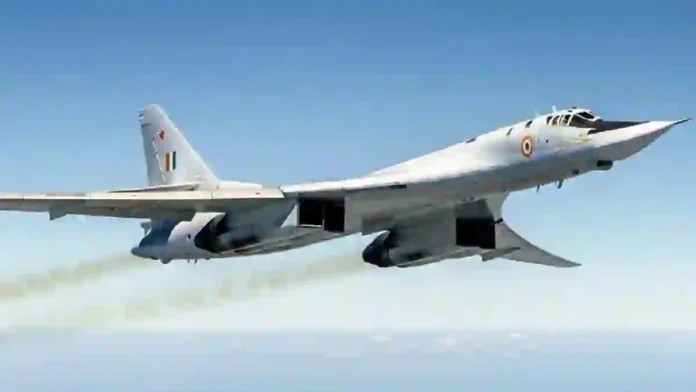by Sourabh Joshi
US deadly strikes on Iranian Nuclear sites of Fordow, Nantz and Isfahan, sparks the debate again should India also invest in its own strategic Bombers?
Early morning strike of B2 bombers on Iranian sites with 12 Huge Bombs of 30000 pound each, extremely fortified sites with underground bases at depth of 90 meters are reportedly destroyed with craters of the size of a football field are visible on satellite images, these visuals sparked instant debates amongst Indian twitter handles should India have it own strategic bombers.
Early morning on Sunday we wake up with Tweet from US president about attack on Iranian nuclear sites of Fordow, Nantz and Isfahan, Donald Trump says the US has carried out a “successful” bombing attack on three nuclear sites in Iran and they have been “obliterated”. Only US had capability to destroy such fortified deep underground bunkers buried 90 meters below surface, using 30000-pound GBU 57 Bombs.
The recent use of U.S. B-2 Spirit stealth bombers in on Iranian nuclear sites—has reignited a long-simmering debate within Indian defence circles: Should India acquire strategic bombers to project credible deterrence and global strike capabilities?
Pros: Deterrence, Depth, And Reach
Though Only three countries—U.S., Russia, and China—operate long-range strategic bombers with both nuclear and conventional roles, US uses B52H/B21 and B2 stealth bombers, Russia uses TU 22, TU 160 heavy bombers, China Uses H6/H6K bombers. UK and France being NATO members have availability of US bombers under NATO leadership in case of a conflict, hence only India among top economies do not have any support of Strategic bombers in case of conflict.
Strategic bombers offer unique capabilities unmatched by current Indian Air Force assets:
Long-Range Precision Strike: Can reach targets deep inside adversarial territory without refuelling.
Flexible Payload Delivery Heavy Carpet Bombing: Capable of deploying nuclear and conventional munitions, stand-off weapons, or hypersonic glide vehicles, capable of heavy bombing taking out heavy fortified sites in mountains where 20/30 thousand tons of heavy bombs are required to make a difference.
Read- ‘Time For India To Be More Vigilant,’ Says Defence Expert As US Joins Israel-Iran Conflict
Read- Stealth Frigate INS Tamal To Be Commissioned Into Indian Navy On July 1
Strategic Signalling: A visible and mobile platform for deterrence—offering flexibility that static missile silos or submarines cannot.
Two-Front Strategy Support: Can neutralise high-value targets or infrastructure in one theatre while supporting operations in another.
As China pushes forward with its H-20 stealth bomber and Pakistan deepens air defence coordination with Beijing, thus it might be available to them in case of major conflict, India risks falling behind.
“Air power is not just about dogfights—it’s about reach and response. India needs the capability to respond anywhere, anytime,” argues a retired Air Marshal.
Cons: Cost, Doctrine, And Alternatives
Opponents argue that India’s strategic doctrine and resources don’t justify such a massive investment:
Prohibitive Cost: Strategic bombers like the B-21 Raider can cost $700 million+ per unit—not including infrastructure, training, and maintenance.
Doctrinal Mismatch: India’s No First Use (NFU) nuclear posture and minimum credible deterrence make bombers less essential than missiles or submarines.
Emerging Alternatives: Hypersonic missiles, armed UAVs, and long-range cruise missile systems (like BrahMos-II) may provide better ROI.
Vulnerability During Wartime: Even stealth bombers could be exposed in heavily defended zones like China’s A2/AD bubble.
Operation spiderweb gave another reminder that how Ukraine’s Cheap drones smuggled deep into Russia destroy priceless and rare Russian strategic bombers worth billions of dollars.
“Bombers are Cold War relics in a world of satellites, missiles, and drones,” says a strategic affairs expert from New Delhi.
Middle Ground: Indigenous Innovation Or Partnership?
Rather than buying off-the-shelf Western systems, some suggest India should:
Co-develop and integrate Indian version of TU 160 blackjack with Indian large GAN bases AESA radar which can be one of the best systems of its kind and equip it with a dozen BrahMos 2 Hypersonic missiles. One squadron of the same should provide India with unprecedented flexibility
Accelerate development of Ghatak, India’s unmanned combat air vehicle (UCAV).
Invest in air-launched hypersonic delivery systems that can be carried by Su-30MKIs or future fighters.
This approach avoids the sticker shock of full bomber fleets while preserving strategic depth and technology sovereignty.
Conclusion
Do the strategic bombers fit in in overall strategy?
India stands at a crossroads: balancing ambition with pragmatism and reach with restraint. While strategic bombers offer prestige and power projection, the smarter question may be:
Can India achieve the same deterrent effect through smarter, faster, and more survivable systems?
In a world of hybrid threats and multi-domain warfare, strategic impact might not require strategic bombers—but it will require strategic thinking.
However limited quantity of a highly Indianized variant of TU 160 Bombers may be handy in case of all-out war. These heavy bombers apart from being huge bomb trucks can also become mother ship of Ghatak unmanned bombers and other hypersonic/ super sonic long range loitering munition India is planning for future.
Sourab Joshi is an enthusiast who tracks military and aerospace issues closely. Views expressed above are the author’s own
Agencies




